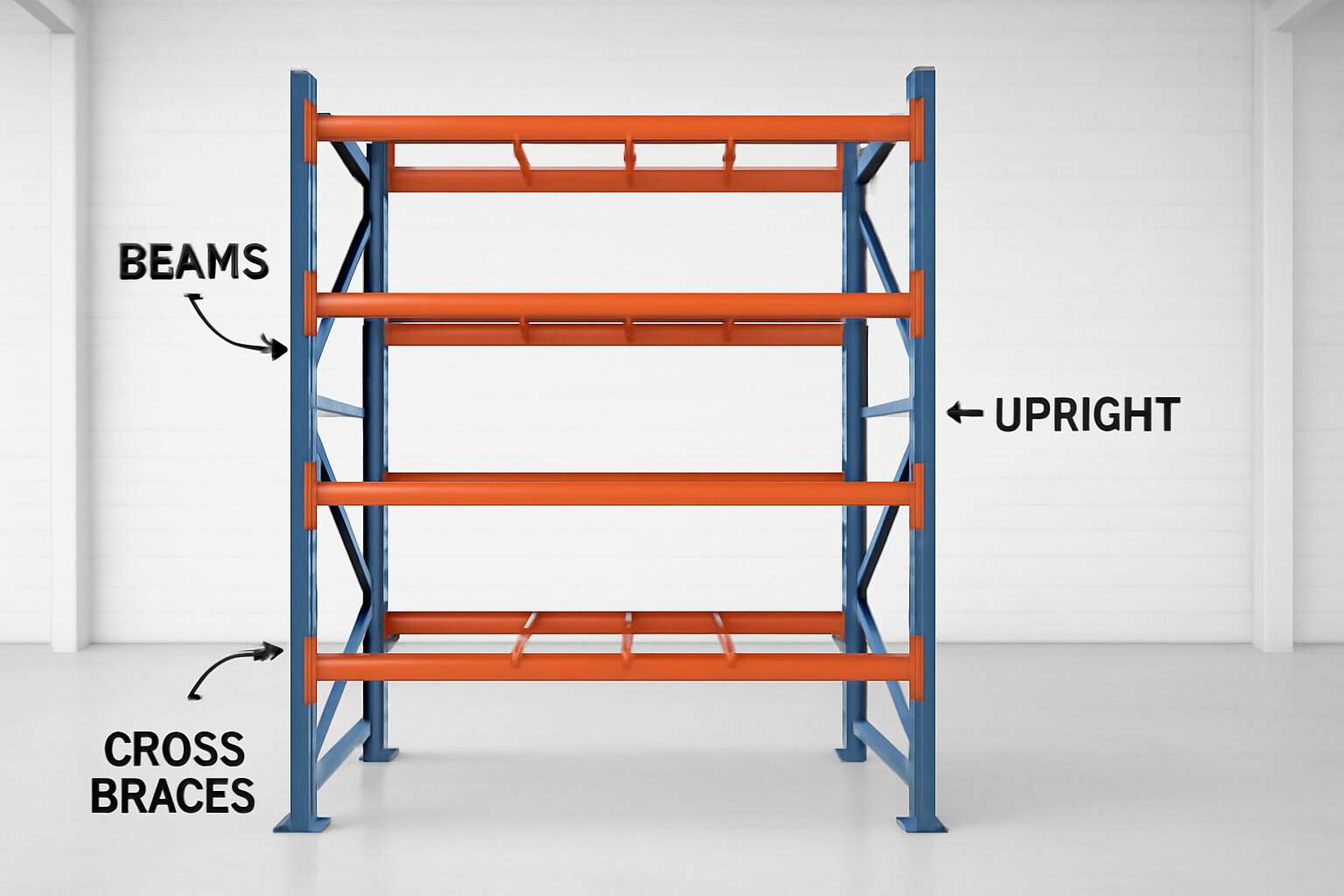Understanding Pallet Racking Systems
Types of Pallet Racking
Understanding pallet racking systems reveals a world of strategic storage solutions that can transform any warehouse. With the right design, you maximize space and improve efficiency—crucial in South Africa’s bustling logistics landscape. The *pallet racking system diagram* serves as a blueprint, illustrating how each component interlocks to support heavy loads and streamline operations.
There are several types of pallet racking, each suited to different needs. Selective racking is the most common, offering direct access to every pallet, while drive-in and drive-through systems optimize for high-density storage. Cantilever racks are perfect for irregular loads, and push-back racking provides a dense, dynamic solution.
By understanding these variations, businesses can tailor their storage architecture to meet specific demands, ensuring safety, speed, and scalability in every *pallet racking system diagram* they implement.
Benefits of Proper Racking Layouts
In the intricate world of warehouse storage, the layout is often the silent architect of efficiency. A well-designed *pallet racking system diagram* does more than just illustrate; it reveals the very soul of operational harmony. When the components interlock with purpose, they unlock a potential that transforms chaos into order, space into productivity. The human element lies in understanding that each element in the diagram isn’t merely a part—it’s a vital piece of a larger narrative of safety and scalability.
Proper racking layouts are not just about maximizing space—they are about creating an environment where speed and safety coexist. In South Africa’s dynamic logistics scene, this harmony can be the difference between stagnation and growth. The *pallet racking system diagram* becomes an essential blueprint, guiding decisions that impact the entire supply chain. It’s a reflection of foresight, a testament to how strategic design can elevate the mundane into the extraordinary.
Components of a Pallet Racking System
Uprights and Beams
A pallet racking system diagram reveals more than just the layout of storage; it uncovers the intricate ballet of structure and purpose that keeps warehouses thriving. At the heart of this system lie the uprights and beams—two components that form the backbone of efficient storage solutions. These elements are crafted with precision, designed to withstand the weight of heavy loads while maintaining flexibility for various warehouse configurations.
Uprights, often towering like silent sentinels, provide vertical support and anchorage for the entire racking system. They are the foundation that ensures stability, allowing for seamless integration of beams at different heights. Beams, on the other hand, act as the horizontal arms that cradle pallets securely in place. Their versatility is reflected in the way they can be adjusted to accommodate different pallet sizes and warehouse needs.
Understanding the components of a pallet racking system diagram, especially the interplay between uprights and beams, unlocks a new dimension of storage mastery. This harmony between components is what transforms a simple diagram into a strategic blueprint for operational excellence.
Decks and Accessories
Beyond the foundational uprights and beams, a pallet racking system diagram reveals a nuanced network of components that optimize storage efficiency. Decks and accessories are often overlooked, yet they are crucial for adapting the system to specific warehouse needs. Decks, for example, serve as the surface on which pallets rest — sturdy platforms that distribute weight evenly and prevent damage to stored goods. They come in various materials, including steel or wood, chosen for durability and compatibility with load types.
Accessories further enhance the versatility of a pallet racking system. These include wire mesh decks for small parts, safety pins to secure beams, and bar stops to prevent pallets from slipping. Incorporating these elements into your warehouse setup ensures not only safety but also maximized storage density. When interpreting a pallet racking system diagram, recognizing how decks and accessories integrate offers a clearer picture of operational flexibility and safety. This holistic approach transforms simple structural components into a strategic advantage for any South African warehouse.
Additional Components
Beyond the primary structure of uprights, beams, decks, and accessories, a pallet racking system diagram also highlights several additional components that significantly influence warehouse efficiency and safety. These elements often go unnoticed but are vital for tailored storage solutions in South African warehouses. Items such as safety clips, load stop bars, and brace panels are integral to maintaining stability and preventing accidents during daily operations.
One often overlooked component is the row spacer, which helps maintain consistent aisle widths and enhances overall accessibility. For example, a pallet racking system diagram will typically incorporate these spacers to ensure that the system remains flexible for different warehouse layouts. Incorporating accessories like wire mesh decks or bar stops can dramatically improve the safety of stored goods, especially when handling small parts or fragile items.
Understanding these additional components allows warehouse managers to customize their storage solutions effectively, transforming a simple structural setup into a comprehensive logistical network. These details, captured in the pallet racking system diagram, can make all the difference in optimizing space, boosting safety, and increasing operational productivity across South African warehouses.
Diagram Elements of a Pallet Racking System
Structural Layout
Within the shadowed labyrinth of a pallet racking system diagram, each element whispers a story of structural ingenuity. The skeletal framework, often unseen but profoundly felt, forms the backbone of a storage universe where order and chaos collide. The diagram elements reveal more than just lines and labels; they expose the meticulous choreography of beams, uprights, and load-bearing components, all woven into a tapestry of industrial poetry.
Understanding this structural layout is essential for grasping the full potential of a pallet racking system. It’s not merely about stacking goods but about crafting a fortress of efficiency—each component plays a vital role. For example, the integrity of the uprights must be uncompromising, supporting the weight of countless pallets. The beams, like the arms of a dark angel, cradle the cargo, while the decks and accessories transform the framework into a versatile sanctuary for inventory.
In essence, a well-constructed pallet racking system diagram is a blueprint of balance—an intricate dance of forces and materials. Recognizing these elements ensures that each racking solution is both resilient and adaptable, transforming a simple storage space into a realm of industrial mastery.
Labeling and Symbols
Every warehouse whispers a silent language through its pallet racking system diagram—an intricate code of labels and symbols that reveal its hidden architecture. These graphical annotations aren’t mere decoration; they serve as vital cues, guiding operators and engineers through a labyrinth of structural nuances. Accurate labeling ensures that each component, from uprights to beams, communicates its purpose and specifications clearly, reducing errors and enhancing safety.
Within the diagram, symbols often carry specific meanings: a double arrow might denote load capacity, while a cross could indicate a connection point. Recognizing these symbols transforms a simple diagram into a powerful tool of industrial storytelling. For clarity, some systems incorporate an
- element key
- legend
that deciphers every label and symbol, making it accessible to both seasoned professionals and newcomers alike. This meticulous attention to detail ensures that the pallet racking system diagram functions as a precise blueprint—one that safeguards efficiency and resilience in storage operations.
Dimensions and Measurements
Dimensions and measurements form the silent bones of a pallet racking system diagram, revealing its true strength and precision. Every line and figure isn’t just a random mark—it’s a calculated declaration of capacity, stability, and purpose. When engineers interpret these diagrams, they’re decoding a layered story of structural integrity, where even millimeters matter.
In a typical pallet racking system diagram, key elements such as the height, width, and depth of uprights and beams are meticulously annotated. These measurements ensure the system can withstand the weight of the stored goods and adapt to specific warehouse needs. For clarity, some diagrams feature a scale that offers a visual reference—helping professionals gauge spatial relationships at a glance.
Understanding the precise dimensions within a pallet racking system diagram transforms abstract data into tangible safety and efficiency. It’s a delicate balance—where every measurement echoes a commitment to operational resilience—reminding us that in the world of storage, accuracy isn’t just technical; it’s moral. The integrity of the entire system hinges on these details, making the diagram a vital blueprint of trust and durability.
Interpreting the Pallet Racking System Diagram
Reading the Layout
Amidst the shadowed corridors of industrial efficiency, the pallet racking system diagram emerges as a map to an unspoken realm of order and chaos. Interpreting this diagram is akin to deciphering an ancient manuscript—each symbol and line whispers secrets about the labyrinthine structure of your storage domain. It’s not merely lines on paper; it’s a gateway to understanding how every beam and upright converges in silent harmony.
When reading the layout, attention must be paid to the subtle cues embedded within the diagram. Symbols denote load capacities, while the spatial arrangement reveals pathways that breathe life into the warehouse. A well-constructed pallet racking system diagram provides clarity, guiding the eye to essential details that ensure safety and efficiency. Sometimes, a simple numbered list can unravel the complexity:
- Identify the designated aisles and their directional flow.
- Note the placement of load-bearing components.
- Observe the symbols indicating safety zones and accessibility points.
In the shadows of meticulous design, understanding the layout becomes an act of silent reverence—an acknowledgment of the unseen order that keeps the warehouse alive and thriving. The pallet racking system diagram isn’t just a blueprint; it’s a story told in lines and symbols, waiting to be unraveled by those who dare to read between the shadows.
Using the Diagram for Installation
Interpreting the pallet racking system diagram is a critical step that bridges the gap between design and practical installation. It’s not just about understanding where beams and uprights sit; it’s about visualizing the entire ecosystem of your warehouse. Using the diagram during installation ensures every component aligns perfectly, safeguarding both safety and efficiency. A clear grasp of the diagram allows for precise placement of load-bearing components and safe access points, reducing errors that could cost time and resources.
To make the most of the pallet racking system diagram, consider these key steps:
- Review the symbols indicating safety zones and flow directions.
- Cross-reference measurements with actual warehouse dimensions.
- Ensure load capacities are respected at each point.
Applying the diagram as a guide during setup transforms a complex blueprint into a smooth, coordinated process. It’s a silent conversation between design and reality—each line and symbol whispering secrets that turn raw space into an organized haven of productivity.
Common Errors to Watch For
Interpreting the pallet racking system diagram isn’t just about reading lines and symbols. It’s about catching potential pitfalls that can turn into costly mistakes. One common error is misreading load capacities—assuming a beam can carry more than it actually can. This oversight can compromise safety and lead to structural failure. Another frequent slip-up is confusing safety zones with workflow pathways, which might cause accidents or disrupt warehouse operations.
Pay close attention to the details in the pallet racking system diagram. Overlooking proper measurements or misaligning components can cause significant delays. It’s also easy to overlook the importance of consistent symbols—an ambiguous or unclear diagram introduces room for error. Verifying each component against the diagram before installation helps prevent these issues and ensures the pallet racking system functions as intended. Remember, a small misinterpretation can ripple into larger problems down the line, so vigilance is key.
Software and Tools for Creating Racking Diagrams
Design Software
Creating a detailed pallet racking system diagram isn’t just about sketching lines on a page; it’s the blueprint for warehouse efficiency. Luckily, modern design software has revolutionized how we visualize these complex systems, turning what used to be a daunting task into an almost enjoyable exercise—yes, really! With intuitive interfaces and precise measurement tools, these programs help ensure every beam and upright fits perfectly, avoiding costly mishaps down the line.
Popular software options include CAD (Computer-Aided Design) programs like AutoCAD and SketchUp, which allow for meticulous planning and easy modifications. Additionally, specialized warehouse design tools such as EasyRack or Pallet Rack Designer streamline the process further, providing templates and industry-specific features. A well-crafted pallet racking system diagram not only clarifies design intent but also acts as a communication bridge between engineers, installers, and warehouse managers—saving time, money, and a few gray hairs along the way.
When selecting design tools, consider these factors:
- Ease of use for non-technical staff
- Compatibility with standard measurements
- Ability to incorporate accessories and structural components
Benefits of Using Diagrams
In the realm of warehouse mastery, the creation of a precise pallet racking system diagram is akin to conjuring a map for treasure. When harnessed with the right design software and tools, this process transforms from a mundane task into an act of strategic wizardry. Modern programs such as AutoCAD or SketchUp serve as enchanted canvases, allowing planners to craft intricate blueprints that reveal every beam, upright, and accessory in perfect harmony. The clarity these diagrams provide is invaluable, illuminating potential pitfalls before a single bolt is tightened.
Benefits of using detailed pallet racking system diagrams extend beyond visualization. They act as a universal language, bridging communication gaps between engineers, installers, and warehouse managers. This synergy ensures that the final installation aligns flawlessly with the design intent, saving time and resources. Moreover, these diagrams facilitate seamless integration of accessories and structural components, enhancing warehouse efficiency and safety. In the end, a well-crafted diagram isn’t just a plan; it’s the cornerstone of a resilient, efficient storage universe.
Best Practices for Designing Racking System Diagrams
Compliance and Safety Standards
Designing a pallet racking system diagram that adheres to compliance and safety standards is no ordinary task—it’s an art form that balances precision with foresight. In South Africa, where warehouse safety regulations are becoming increasingly stringent, a well-constructed diagram acts as the blueprint for a resilient and secure storage environment. The key lies in understanding the intricate dance between structural integrity and operational efficiency, ensuring every component aligns perfectly within the racking system diagram.
To uphold safety standards, it’s crucial to incorporate specific elements such as load capacities, clear signage, and proper spacing. A meticulously prepared pallet racking system diagram should reflect these details, serving as a visual safeguard against potential hazards. It’s also wise to regularly review and update the diagram, especially when modifications or expansions are undertaken. Remember, a comprehensive diagram not only streamlines installation but also fortifies compliance, transforming your warehouse into a fortress of safety and productivity!
Design Tips
Creating a stellar pallet racking system diagram isn’t just about drawing lines and hoping for the best—think of it more as choreographing a well-rehearsed ballet where every element has a purpose. A good design balances safety, efficiency, and future-proofing, ensuring your warehouse is both a fortress of productivity and compliance. It’s tempting to wing it, but a meticulously crafted diagram acts as the backbone of smooth operations, preventing costly errors and mishaps.
When designing your pallet racking system diagram, pay close attention to the flow of goods and space utilization. Incorporate clear signage, load capacities, and strategic spacing—these aren’t just safety features; they’re the secret sauce for operational harmony. Remember, a well-visualized diagram simplifies installation and keeps everyone on the same page, avoiding the chaos of last-minute adjustments.
For added precision, consider using dedicated design software—your new best friend—to develop an accurate and detailed pallet racking system diagram. It’s a small investment that pays off by reducing errors and accelerating project timelines. After all, your warehouse’s safety and efficiency depend on it! And don’t forget, regular review and updates of your diagram keep your storage environment resilient and compliant in the ever-evolving regulatory landscape of South Africa.
Maintenance and Review
Maintaining and reviewing your pallet racking system diagram is the secret sauce to keeping your warehouse running like a well-oiled machine. Think of it as a health check-up for your storage layout—skipping it might save time in the short run, but it can lead to costly mishaps later. Regular audits help identify potential safety hazards, outdated signage, or structural issues that could jeopardize personnel safety and operational efficiency.
To keep your pallet racking system diagram in tip-top shape, schedule periodic reviews—think of it as giving your warehouse a wellness boost. During these reviews, verify measurements, load capacities, and clear signage are up to code, especially with South Africa’s ever-evolving safety standards. Incorporating a systematic approach ensures your diagram remains a reliable reference for installation, maintenance, and future upgrades.
Some best practices include maintaining a detailed change log, so modifications are documented and traceable. Remember, a pristine pallet racking system diagram isn’t just about aesthetics; it’s about safeguarding your investment and ensuring smooth, hazard-free operations for years to come! And always keep an eye out for common errors that can creep in—like misaligned beams or overlooked clearance, which can turn a perfectly planned layout into a logistical nightmare.




0 Comments